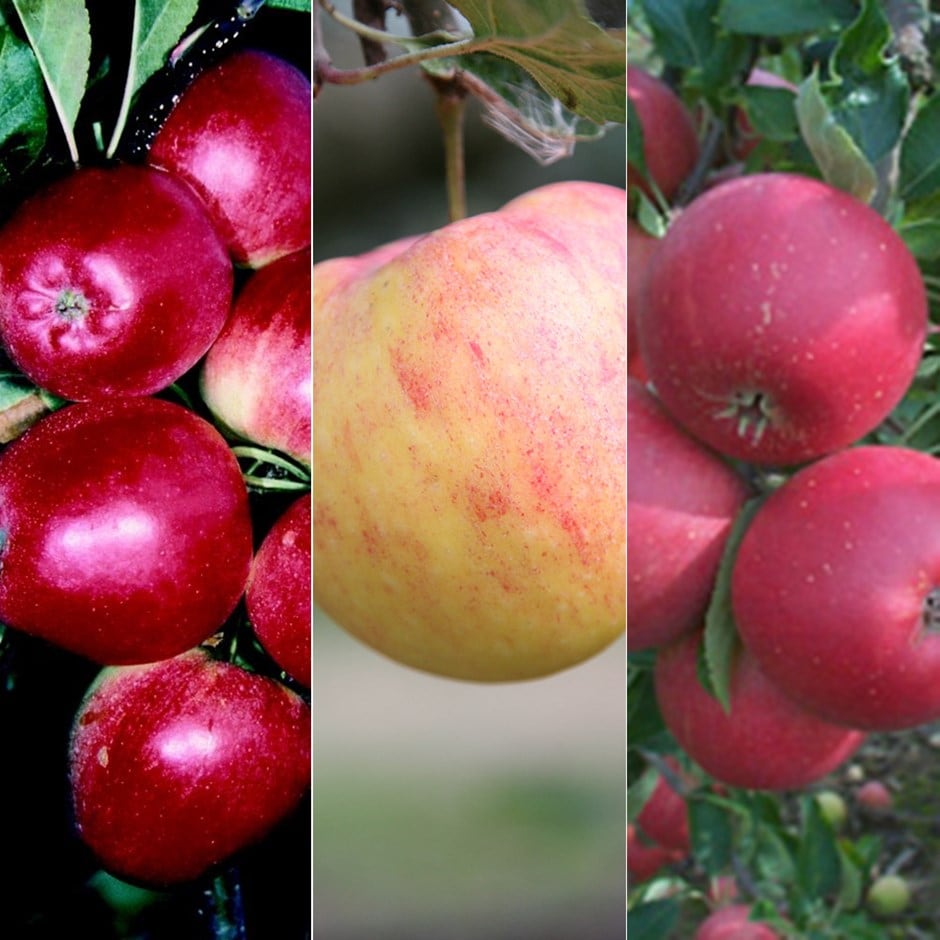apple 'Cox Self Fertile' / 'James Grieve' / 'Katy'
family apple Cox's Self Fertile / James Grieve / Katy
This plant is deciduous so it will lose all its leaves in autumn, then fresh new foliage appears again each spring.
- Position: full sun
- Soil: moderately fertile, moist but well-drained soil
- Rate of growth: average
- Flowering period: April to May
- Hardiness: fully hardy
A wonderful choice for smaller gardens, this 'family' apple tree bears three grafted branches, each producing a different variety of delicious apples. These include:
'Cox's Self Fertile': Regarded by many as one of the best eating apples, their creamy flesh has a superb flavour and sweet aroma. Ready to harvest in October.
'James Grieve': Producing crisp and juicy, red-flushed, green apples that have remained consistently popular since they were first introduced in 1893. A reliable cropper, the apples can be used for cooking or eating and can be harvested from September.
'Katy': A recent introduction that is proving popular for its heavy crop of bright red fruits, which have a firm, juicy flesh with just the right balance between sweet and acid. Ready to harvest from late August to early September, they're excellent for juicing and making cider.
Pollination information: These apple varieties will all cross-pollinate freely with one another, so there's no need for a separate pollinating partner.
'Cox's Self Fertile': Regarded by many as one of the best eating apples, their creamy flesh has a superb flavour and sweet aroma. Ready to harvest in October.
'James Grieve': Producing crisp and juicy, red-flushed, green apples that have remained consistently popular since they were first introduced in 1893. A reliable cropper, the apples can be used for cooking or eating and can be harvested from September.
'Katy': A recent introduction that is proving popular for its heavy crop of bright red fruits, which have a firm, juicy flesh with just the right balance between sweet and acid. Ready to harvest from late August to early September, they're excellent for juicing and making cider.
Pollination information: These apple varieties will all cross-pollinate freely with one another, so there's no need for a separate pollinating partner.
When planting your apple tree, prepare a hole up to three times the diameter of its root system. Fork over the base of the pit in readiness, incorporating plenty of organic matter into the backfill and planting hole. Avoiding frozen and waterlogged soil, trees should be planted out as they arrive. If you've ordered a bare root tree, soak the roots in a bucket of water for half an hour prior to planting - or if this is not possible, they can be heeled in temporarily, covering their roots with soil, or potted up. Once in the ground, stake firmly and keep the base weed-free. Apply a balanced fertiliser in early spring to support growth and fruiting and provide regular watering during hot, dry spells. The main winter prune, avoiding frosty conditions, involves removing dead, dying, and diseased wood to create an open crown. Additionally, reduce leaders and laterals by a third to establish an airy structure without crisscrossing branches. In August, summer prune by shortening side shoots longer than 20cm (8”) back to three leaves, promoting fruit ripening and encouraging more fruit buds.
Goes well with...
-
Fruit tree protector
2m
-
plum 'Czar'
plum Czar
9 litre pot | SJA root stock | 1.2m
-
cherry 'Morello'
cooking cherry (syn. Prunus cerasus Morello)
9 litre pot | Colt root stock | 1.2m
-
greengage 'Reine-Claude Violette'
gage (syn. Prunus domestica (Reine-Claude Group) 'Reine-Claude Violette)
12 litre pot | SJA root stock | 1.5m

